9 Full-Proof Strategies to Increase Healthcare Mobile App Revenue & Customer Base
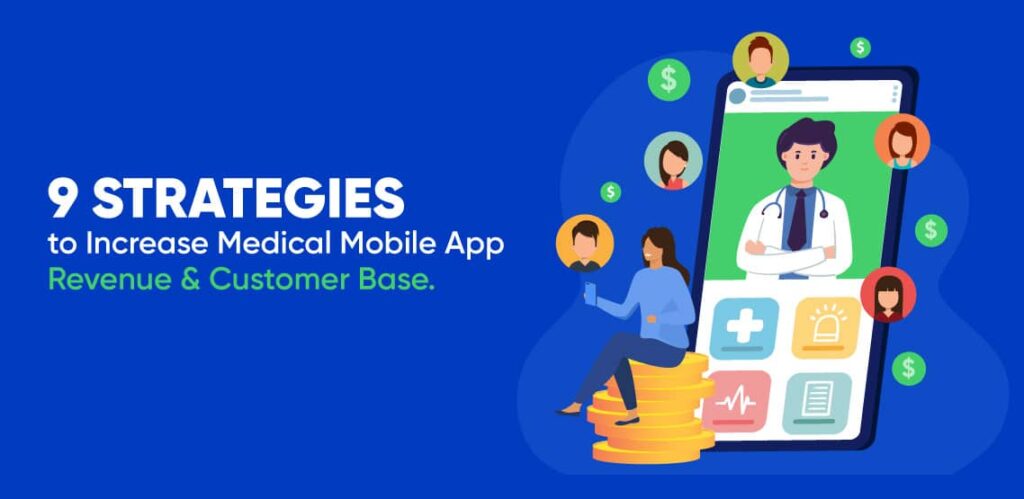
The rapid advancement of the digital industry in the last few years has made it imperative for the rather slow-paced healthcare industry to join hands and redefine the way healthcare reaches people across the globe. Mobile healthcare apps are introducing mobile health solutions (mHealth) and transforming healthcare facilities as we know them. The global mHealth solutions market is projected to reach USD 213.6 billion by 2025 from USD 50.8 billion in 2020, at a high CAGR of 33.3%. This will be a more than four-fold increase. Presently, mHealth apps are trending across all business verticals by holding great promise in improving patient outcomes and reducing the cost of care services.
The total healthcare app revenue generated is expected to grow exponentially in the post-pandemic scenario. Recent statistics reveal that the number of medical apps in Google Play from 1Q15 to 3Q20 has exponentially increased to reach 47,140. This represents an overall 1.68% increase compared to the last quarter. Owing to this increase, more and more businesses functioning in the healthcare sector are integrating their services and products into mobile apps for greater reach and better turnover.
Mobile healthcare apps not only improve the return on investment (ROI) but also offer dynamic growth that utilizes new business models, latest technologies, and new workflows. With the number of mHealth apps increasing substantially, merely investing in mobile healthcare apps is not enough. If your mobile health app is not bringing in the desired ROI for your business, worry no more. We have listed effective ways to make your mobile health app more rewarding and to increase your customer base.
- Most Important Features in Your Mobile Healthcare App
- Healthcare and Medical Mobile App Revenue Models
- 8 Tips on How to Increase Customer Base for Mhealth Apps
- Healthcare App Development With Tech Exactly
Most Important Features in Your Mobile Healthcare App
The success of your mobile healthcare app to a great extent depends upon the functionalities it has to offer. Leading companies who are largely contributing to healthcare industry revenue are primarily focusing on very basic but very important patient-centric features like the below:
1. Online Consultation
Mobile healthcare app development should focus on offering around-the-clock consultations through HD video, audio, or chat. This will enable patients to have direct one-to-one interaction with their doctors from the comfort of their homes.
2. Scheduling of Appointments via Smart Devices
With the help of a good healthcare mobile app, patients should be able to easily check the availability of their respective doctors, select a suitable time, and book an appointment right there to meet.
A modern healthcare app should also allow doctors to accept or deny consultation requests and the patient should receive a notification accordingly.
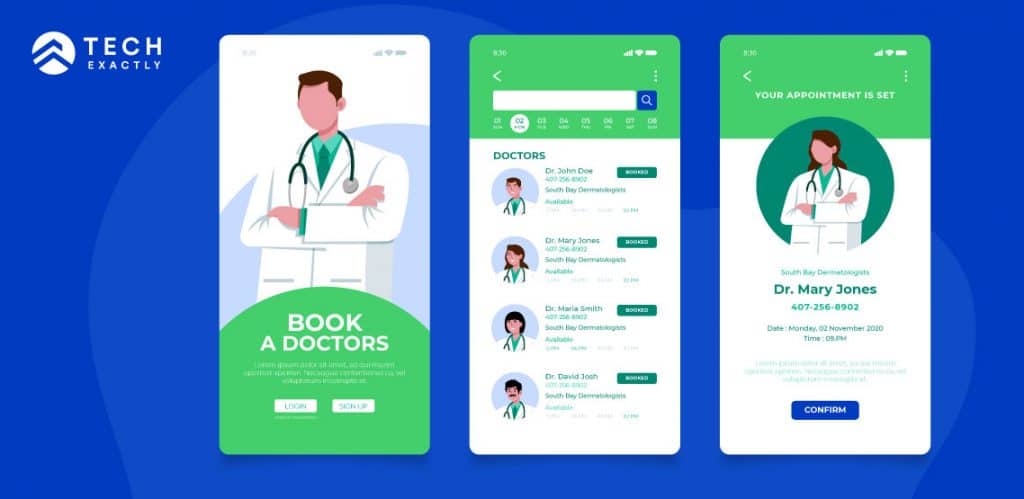
3. e-Prescriptions & Test Reports
An app should eliminate paper-based prescriptions by enabling doctors to prescribe medications directly in the application. Similarly, enables laboratories to imprint the results of medical tests conducted in the patient’s module itself making it simpler for both patient & doctor to access the reports.
4. User Profile & Dashboard
During signup or later, patients should input their basic details like name, age, gender, and past medical history. Similarly, a healthcare provider’s profile must have updated information about experience, certifications, competencies, languages spoken, feedback, ratings, etc.
Dashboards showing real-time user health data and recovery progress enable patients to track their own health and motivate them to be more responsible & alert.
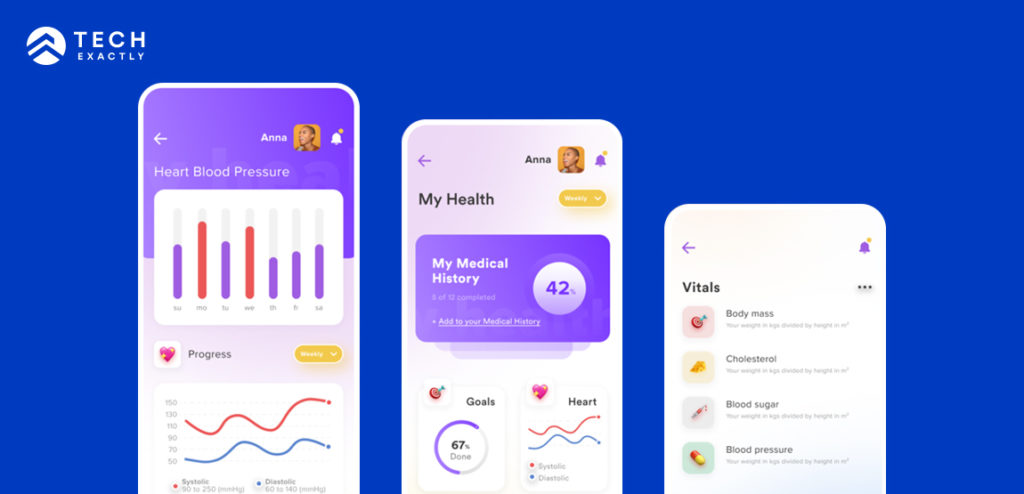
5. Care and Pill Reminders
With an app, a patient will no longer forget to take prescribed medicines on time.
6. Push Notifications
Equip your app to notify both doctors & patients about an upcoming appointment. Please note HIPAA does not permit to inclusion of patient data in notifications.
7. Payment Gateway
For convenience, a patient must have multiple & secure payment options at its disposal so that he/she can directly pay from the health app. In addition, both users must be able to view payment history and past invoices for future reference.
8. Search & Filter Feature
Let users find healthcare providers, doctors, clinics, and pharmacies, and filter the results based on location, experience, rating, etc.
9. Geo-location
A modern healthcare app should be able to map doctors & medical facilities nearby. This will help your patients reach the desired location in the shortest time.
10. Storage for all Medical Records
Your medical app should be a one-stop shop for your patients. Hence, have a database to store all patient electronic medical records like ECG, x-ray report, blood test report, diet & nutrition chart, and prescriptions, in one place. This adds to the convenience of making relevant information available to the concerned parties any time.
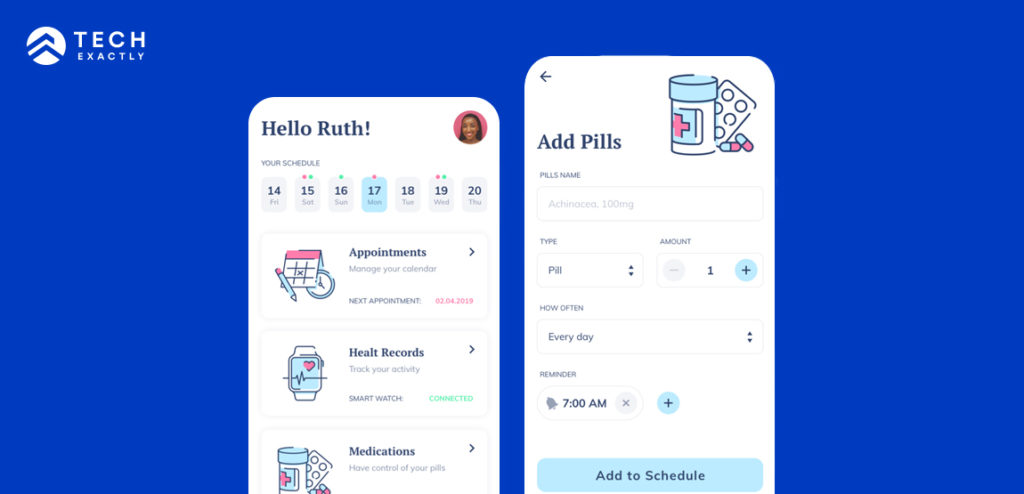
Healthcare and Medical Mobile App Revenue Models
Generating the desired level of profit from a mobile healthcare app is tough & time consuming. In addition to validating the target market, it is necessary to implement a mHealth app monetization strategy that suits the needs of your business.
Let us take a look at some mHealth revenue models that will help you make more money out of your mobile healthcare app.
1. Freemium Model
This is the most common model of monetizing an app. As the name suggests, you as an app owner offer two versions of the same app –
- Free version – providing access to basic functionalities
- Premium version – is chargeable and provides access to advanced and premium features
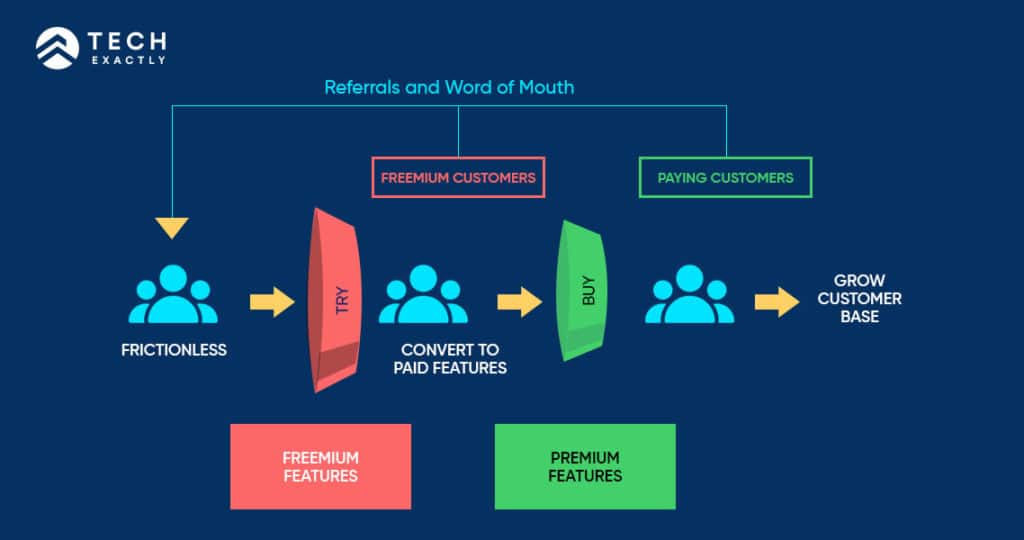
The goal of this model is to attract a large number of initial users to try the basic functions of the app, and if they are satisfied, they will be allured to pay to use the advanced features too. This gives the users an opportunity to know what they’re paying for. But you must create value for the users and make it compelling for them to spend money on whatever you plan on offering.
A few tips to make freemium model work best include –
- Give a free trial to the full-feature app
- Remind users to upgrade frequently
- Study usage patterns and identify prospective conversions.
2. Content Monetisation
In medical science, it is very critical for practitioners to have detailed knowledge & up-to-date news related to their subject. Mobile phones make learning possible anytime, anywhere. But everything that’s available on the internet might not be true, which is dangerous. Hence, it’s completely fair to provide certified and premium content in your mhealth app for a fee.
For instance, doctors will be able to view a fixed amount of content on your app for free. After which, all they need to do is sign up and pay a subscription fee that allows them to get access to more certified content (including news on the latest technology, research, tips, etc. in the medical sector) that is updated regularly. And once they subscribe, the payment is fairly recurring.
To get this model running, you must have a consistent content publishing strategy & infrastructure to publish high quality medical content regularly.
3. Registration and subscription fees
Most medical apps act as a platform to connect doctors with patients. You can monetize your app by charging a one-time registration fee from medical practitioners, wellness experts, hospitals, etc. Who wish to utilize the app to fill in their empty time slots. Once you have a good client base, you can elevate this model by charging them a monthly fee to stay registered and allow interested patients to schedule appointments with them.
Similarly, you can strategize a subscription model that allows your users to choose a subscription plan as per their preference and pay a fixed fee (say, monthly, quarterly, or yearly) to use the app.
4. In-app advertisements
This app monetization strategy is among the frequent choices because it’s quick & easy to implement. But ads can be rewarding only if they don’t disrupt the main user experience. Hence, the key to the success of the model lies in offering only relevant advertising. You can pair up with local mobile advertising partners that use advanced technologies like RFID, NFC, or Beacon to generate real-time targeted mobile ads for improved on-the-spot user experiences. For instance, when close to a drugstore with a beacon, an app user gets a notification about discounts on medicines that they buy often.
Organizations use several ad formats to serve their users – banner ads, native ads, full-screen ads, and video ads. Each ad network will pay you on the basis of the quality & quantity of ads. Common terms include cost per click, cost per install, cost per mile, etc.
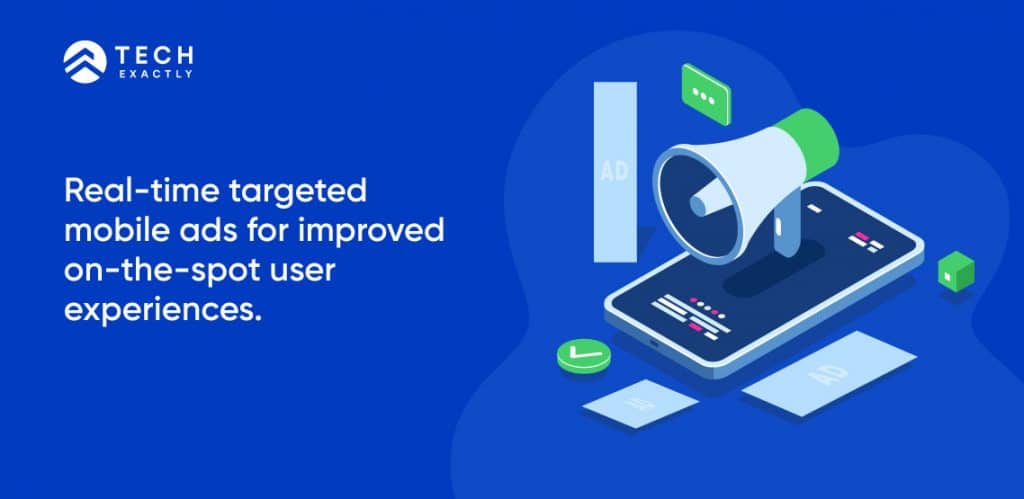
5. In-app purchases
Despite being fairly complex, this is one of the most profitable & successful mHealth in-app revenue sources. In-app purchases usually come in multiple forms. Say, for a gamification app, users can buy extra lives or one-time cheats, for fitness apps, these appear as extra workouts, for medical applications, it enables patients to pre-pay visits, purchase supplements or get their prescriptions refilled.
Merchandising is another option that apps can consider. Your app can act as a marketplace for selling your home-owned or external brand products to users. For instance, in India, the Cure. Fit app sells their home merchandise (sports shoes, tees, track pants, etc.) on their app.
6. Sponsorship
Sponsorship is essentially a mix of ad formats promoting a limited number of brands or even a single business within one app. If your app has a big user base and a high level of user engagement, consider brainstorming what other company can benefit from offering its products or services to your audience and conversely how it will benefit your users.
The way you integrate a sponsor into your app depends on the product and the goals of the partner. Some simple options include placing the sponsor’s logo in the footer or splash screen, providing special offers from the sponsor, showing sponsors’ ads, etc. Typically, ads for sponsors are more static in nature, and you can tailor them to the needs of the brand.
The trick to make this strategy work is to find sponsors in the medical field who share the same target audience. Attending healthcare conferences and exhibitions will help you do the same.
7. Monetizing accumulated data
Selling users’ data might not sound very nice and ethical at the very beginning but this is, in fact, a legal way of making money. Wondering if data monetization is possible in healthcare? Here’s the good news! Yes, there are multiple legal methods to sell accumulated health data. But the catch here is – Anonymity. App owners can sell only those data that are not personally identifiable. Such anonymous data can be used for predicting trends and drawing insights. For starters, you can use the app to track the lifestyle of overweight patients who underwent gastric bypass surgery. The collected data can be of value to life insurance companies, pharmaceutical companies, or fitness experts.
8. Promotion
As per this revenue model in the mobile health industry, you can use a healthcare app for special offers or discount promotions. For this, collaborate with third parties who are willing to promote their services and products. To make this strategy successful, all you need to do is find products and services that will be appealing to your app users. For example, with your mhealth app, you may promote a medical center that is offering discounts on lab tests.
9. Gamification
Get creative to offer paid gamification elements to engage users. In case of medical apps, you may incorporate games to help users stick to their routine exercises, or take medications on time. You can make this more interesting by offering rewards in terms of free medical advice, discounts, bonus points, etc. This model is more appealing to adults with kids as games can keep children entertained while they are undergoing treatment.
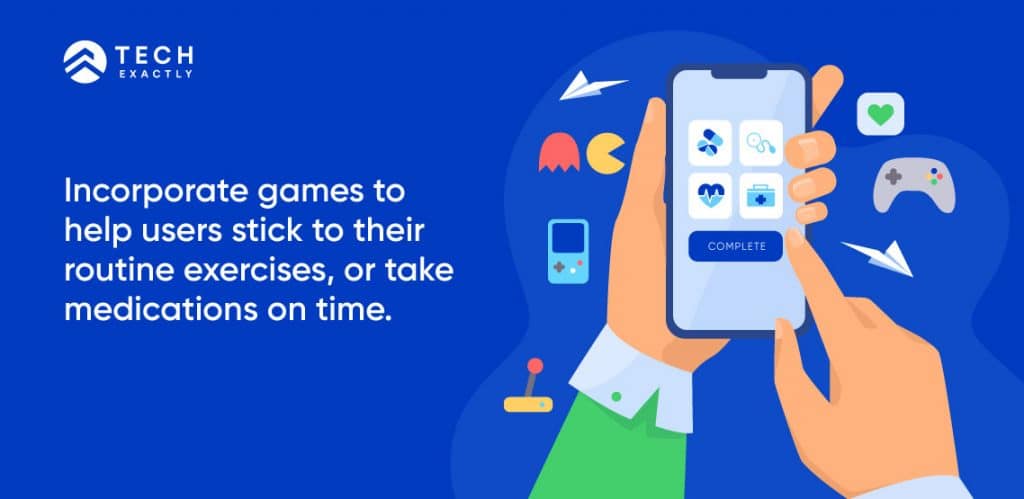
8 Tips on How to Increase Customer Base for Mhealth Apps
If you have been trying to expand your revenue from mhealth app, your customers should be your main point of focus. Out of my experience in building umpteen health apps now, I have jotted a few smart tips to help you build a user base. Follow these suggestions and you will start enjoying a loyal customer base in no time.
1. Understand your customers
Start from scratch by defining who your end users are, what do they expect from an app & how they want to use it. Some ways to do this:
- Do a market study, with the help of say conducting surveys online or offline, or interviewing your stakeholders directly. This might help you get highly actionable & meaningful insights for your app.
- Study your competitors & the services they offer. Look for customer reviews & comments on such apps and see if the competitor is missing out on something that customers desire. This provides you with a lucrative opportunity to offer something new and desire. Hence is a great way to build brand popularity.
- If your app is already released, ask for customer feedback and work on addressing their issues or regularly adding new features.
2. Your app should solve a problem
It always makes sense to offer a solution to any existing problem or to offer something that is innovative & not available in the market yet. Become the ‘go-to’ company and quickly build your customer base.
3. Improve customer service by incorporating important features
Leading mHealth apps are focusing on providing a seamless experience and ultimate convenience to their users. While it’s always better to have unique & advanced features in your app, basic ones should not be ignored. Be mindful of the following during app development:
- Keep the user interface simple, attractive & interactive.
- Keep your target consumers in mind while designing your app. For example, if you are targeting old people, your app should have larger text and bigger icons.
- Avoid using technical medical terms to keep your patients engaged.
- Your app should be intuitive to use. Remember, patients will not use an app that adds extra time to what they currently spend on caring for themselves. If your mobile app requires patients to spend a long time to figure out how it works, they’ll no longer use your app.
- Provide easy access to all the necessary functionalities like booking or canceling an appointment, setting reminders for pills, record keeping, etc.
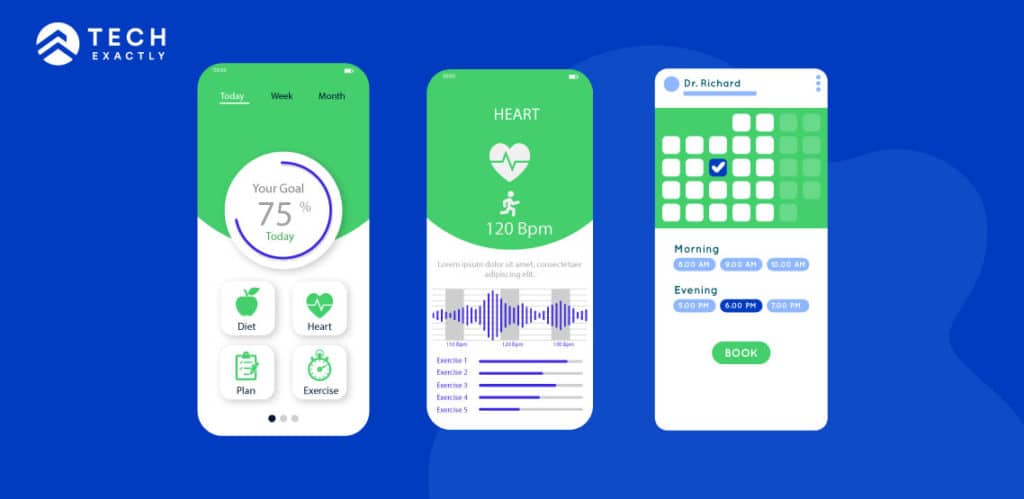
4. Ensure your customer’s data is secure
The study says that concerns over data privacy & security are one of the major hindrances in the adoption of mhealth platforms. Data breaches happening worldwide have made patients more protective of their personal health information. Hence, as an app owner, it is extremely important for you to keep patient’s data secure and to convey to users that you care about them. Some ways to do this are:
- Study regulatory compliances applicable to you and ensure your app adheres to all the regional requirements like HIPAA, GDPR, etc.
- Enable multi-factor authentication for extra security
- Encrypt all data, whether, at rest or in transit
- Establish secure network connections (For example – https)
- Run vulnerability tests regularly to check for bugs & loopholes and immediately act upon findings.5.
5. Integrate with Wearable Technology
Smartwatches, fitness trackers, and other wearable devices are fast gaining popularity and hence offer an excellent opportunity to develop a healthcare app that is compatible with wearable technology. Consider this stat – The global wearable healthcare devices market is projected to reach USD 46.6 billion by 2025 from USD 18.4 billion in 2020, at a CAGR of 20.5%.
Using this platform, users are able to track their real time vitals like heart rate, glucose level, sleep patterns, etc, making them more engaged & informed about their own health.
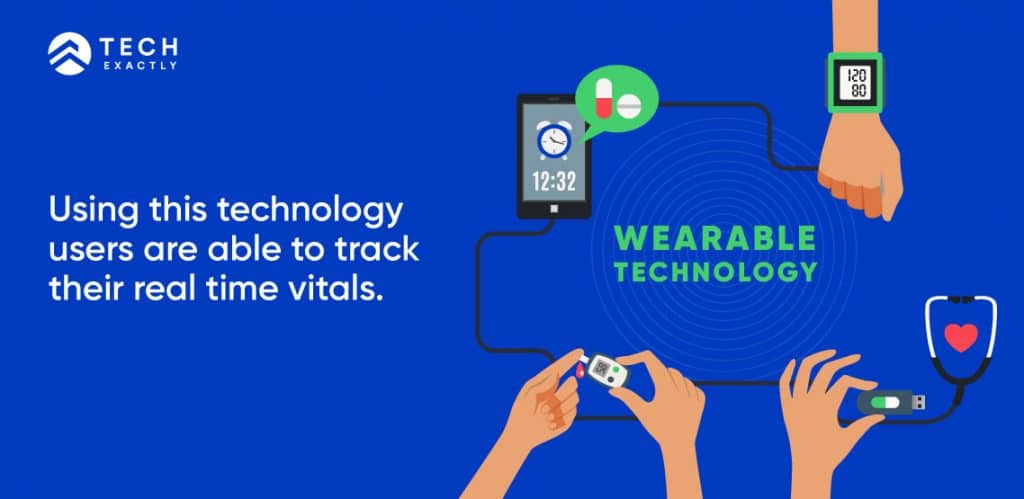
6. Avoid hidden or unexpected costs
According to a survey published in the Journal of Medical Internet Research (JMIR), close to half of smartphone users stop using mHealth apps after downloading primarily due to hidden costs, high data entry burden, loss of interest, or security and privacy concerns.
Hence, it’s always best to clearly convey to users which features are being offered for free and which ones require payment. Not everyone is against paying for advanced & useful features in an app.
7. Update your app regularly
To keep your users engaged, ensure everything is always running smoothly. Fix identified bugs immediately. Also, make your app compatible with a new operating system or hardware series as soon as possible.
8. Revisit your marketing strategy
To increase app downloads, create a marketing campaign around your app. Start with giving your brand a boost to capture people’s attention. Increasing social media presence, and brand storytelling through guest posts, email newsletters, SEO, and website promotions are some platforms through which you can promote your mhealth app.
Healthcare App Development With Tech Exactly
Before choosing a suitable monetization strategy for your operations, it’s important to first understand the type of your app and the features your app offers. Moreover, it’s always better to decide the best suited model at the inception stage of the app, because then it’s easier to design the architecture of the app and you get your income right from the beginning.
Deciding which monetization strategy works best for your app can be quite tricky. This is why you should trust professionals to create a combination of revenue models that will definitely raise health app revenue. If you intend to grow mobile health app revenue, we can apply our experience to help you build a secure revenue-generating medical mobile app.
At Tech Exactly, we specialise in creating secure digital solutions with unmatched models for service revenue in healthcare apps. Our team of skilled application developers holds vast experience in AI, IoMT (Internet of Medical Things) and other emerging technologies enabling you to develop a seamless patient-centric platform. All you need to do is brief us on your app idea and we will assist you right from inception to launch to post-launch. Give us a call to discuss your health app idea and watch us take your business to new heights of success.
